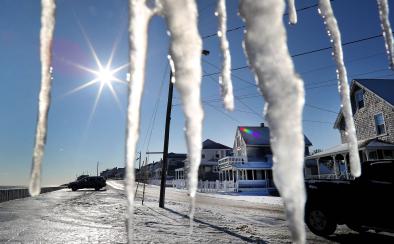Science Source
An Updated Blizzard Climatology of the Contiguous United States (1959–2014): An Examination of Spatiotemporal Trends
A strong positive trend in annual blizzard frequency exists, particularly in the past two decades. Ultimately the increased blizzard activity trend has a large component related to data quality issues early in the record, but the entire trend cannot be fully explained by these issues alone.
Dr. Jill Coleman, associate professor at Ball State University, the study's lead author
- Compiles blizzard occurrence by county for the conterminous United States from Storm Data for 55 winter seasons from 1959/60 to 2013/14
- Examines spatiotemporal patterns for blizzard seasons (September–August) at annual, decadal, and monthly frequencies
- Uses linear regression and spectral analysis to detect any blizzard cycles or trends
- Finds a strong positive trend in annual blizzard frequency, especially in the 2000s as highlighted by the 2007/08 season, which recorded 32 blizzards
- Finds the number of blizzards each season in the U.S. rose from about 6 at the beginning of the study to 21 to 22 by the 2013-2014 season
- Finds that while annual blizzard counts increased substantially in the past two decades the average area covered by blizzard events displayed a marked decrease; a regression analysis showed the trend to be significant
- States that the observed trends in blizzard counts and event sizes may be related to reporting protocols, increased detection capabilities in remote regions since the NWS modernization era, and greater blizzard awareness through social media
- Tallies societal impacts such as fatalities, injuries, property damage, and federal disaster declarations
- Data revealed:
- 713 blizzards over the 55 years, with a mean of 13 events per season
- Seasonal blizzard frequency ranged from one blizzard in 1980/81 to 32 blizzards in 2007/08
- Average area per blizzard was 83 474 km2, or approximately the size of South Carolina
- Blizzard probabilities ranged from 1.8% to 76.4%, with a distinct blizzard zone in North Dakota, western Minnesota, and northern South Dakota
- Every month except July, August, and September has reported blizzards with a peak occurrence in December and January
- Federal disaster declarations resulting from blizzards totaled 57, with more than one-half of them occurring in the twenty-first century
- 711 fatalities during the 55-yr study period, with an average of one individual per event
- 2044 injuries were reported, with a mean of nearly three per blizzard
- Property damage totaled approximately $9.11 billion in unadjusted dollars, with an approximate mean of $12.6 million per storm
- Figure one: Annual blizzard frequency for the 1959/60–2013/14 seasons subdivided into 3-month intervals

Related Content
Science Source
| Science Advances
A stratospheric pathway linking a colder Siberia to Barents-Kara Sea sea ice loss
Pengfei Zhang, Yutian Wu, Isla R. Simpson et al
Science Source
| Geophysical Research Letters
Observations reveal external driver for Arctic sea‐ice retreat
Dirk Notz, Jochem Marotzke
Science Source
| Nature Communications
Warm Arctic episodes linked with increased frequency of extreme winter weather in the United States
Judah Cohen, Karl Pfeiffer, Jennifer A. Francis
Headline

Jan 17, 2018 | Weather Underground | Category 6
Extreme Temperature Workout: The Gyrations of January 2018


